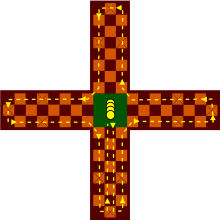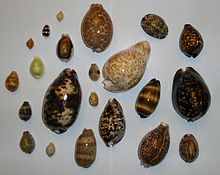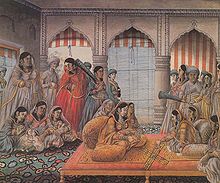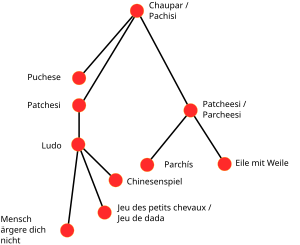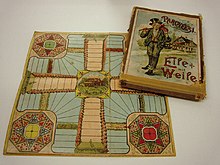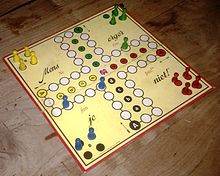Pachisi
Pachisi (pronounced Pachisi , from Hindi पच्चीस paccīs 'twenty-five') is one of those games on which the “game culture” of Europe is built. Originally from India , it was brought to the West via England and the USA in the 19th century, creating many new variants. In Germany, in particular, Mensch ärgere dich nicht is common, in Switzerland Haste with a while and in English-speaking countries especially Ludo and Parcheesi .
Pachisi is a younger and simpler variant of the game Chaupar (also Chaupad , Chaupur , Chaupat , Chausar or Pat in Sanskrit ). The Chaupar board is the same, only the rules are more complicated. Chaupar was the more aristocratic game, Pachisi was a popular game. Today, Chaupar is just as popular with the Indian population as Pachisi.
history
History of Chaupar
The story of Chaupar can practically not be separated from that of Pachisi. The game is believed to have developed in the 4th century as a modification of the Korean game Yut , which spread westward a long time ago and thus came to India. Chaupar is seen as the more courtly game. At Chaupar you will discover rules of the game that are known from the Korean game Yut, e.g. B. the possibility of merging two game pieces. This also shows the close relationship between Yut and Chaupar and Pachisi.
In Delhi and Agra , large marble game boards were found in the palaces, suggesting that live figures were being played. A legend reports that in the 16th century the Mughal Mughal Akbar I is said to have played the game outside with sixteen harem slaves dressed in four different colors on a large marble game board instead of with normal pawns. In Ā'īn-i Akbarī , both the game Chaupar and the further development Chandal Mandal are explained for sixteen players. A lithograph of this text from 1855 contains drawings for it.
Story of Pachisi
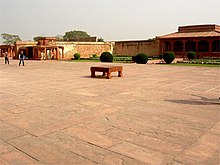
The oldest written reference in Europe can be found in a book by Thomas Hyde De Ludis orientalibus from 1694. From this it can be concluded that the game was brought to Europe by English travelers.
The game Pachisi was created in the 6th century. It first came from the British from India to Europe in the 19th century as Patchesi to England and as Patcheesi to the USA. Many modifications have emerged from these two versions over time. The first modification is the game The popular Game of Patchesi by John Jaques & Son, London , from 1863. Another early modification of the game is Parcheesi, The Game of India , published in 1874 by Selchow & Righter and was copyrighted.
Towards the end of the century, this gave rise to the game Eile mit Weile in Switzerland and Germany . The game has practically disappeared in Germany because a new Parachisi descendant that emerged at the beginning of the 20th century became very popular: Mensch ärgere dich nicht .
The reason for the changes in the individual countries could have been trademark law. A slightly modified game could be published without any problems, but the original was not.
Further variations are the Spanish Parchís , the English children's game Ludo and the French Jeu des petits chevaux .
Pachisi
regulate
The following rules are taken from The History of Board Games (1999) by David Parlett .
Each of the four colors plays with four stones (figures) which are drawn from the center ( char koni ) over the middle path of the arm that is facing the player. The pieces are then pulled counter-clockwise over the left and right lanes of the arms and finally back over the middle lane to the center.
The players with the black and red stones ( goti , "horses") form a team and those with the green and yellow stones form the opposing team. Both teams play against each other. The players of a team sit opposite each other. The players on a team do not throw each other out. If one of the players has all of his stones in the goal, he still rolls the dice and his points are set with his partner's stones.
roll the dice
You roll the dice with five to seven cowrie snails and count the openings pointing upwards.
| Openings on top | five cowrie shells | six cowrie shells | seven cowrie shells |
|---|---|---|---|
| 0 | 25+ | 25+ | 7th |
| 1 | 1 | 10+ | 11+ |
| 2 | 2 | 2 | 2 |
| 3 | 3 | 3 | 3 |
| 4th | 4th | 4th | 4th |
| 5 | 5+ | 5 | 25+ |
| 6th | 6+ | 30+ | |
| 7th | 16 |
25 is the best throw with five and six cowries, and hence the name of the game. In Hindi , 25 means “pachis”.
The first player is drawn counter-clockwise. Everyone rolls once. The player with the highest roll goes first. He throws the snails again and then places a figure on the center and pulls it out along his path with as many steps as his throw corresponds. If a player had a throw that was marked with a (+) in the table, then he may either move a piece that is already in play exactly one space forward or a new piece (of his own, not those of his partner ) bring into play. Then he can throw again. After three throws with a (+) there is a penalty, which can vary depending on the variant.
A player does not have to draw a throw if he does not want to, e.g. B. if the result would lead to a worse position.
Beat pieces
A piece of an opposing player is captured when a piece of one's own comes onto the field of an opposing piece that is not on a safe field (usually shown as an X). The captured piece must be brought back into play by the opponent using the usual rules. If a token is on a safe space, no other token can be moved onto this space.
Put the pieces together
Some variants make it possible that two pieces can join together, as is the case with Chaupar. Two pieces of one color can then be put together to form one. They are drawn like a stone and are also struck like a stone. In addition to the higher benefit (faster forward movement), there is a higher risk (two stones are hit at the same time).
Barriers
The barrier formation occurs only in many western Pachisi descendants. It is questionable whether these actually come from a variant of this Indian game.
Two stones of the same color form a block when they come on the same space. This blockage is maintained as long as no block-forming figure is pulled away. No other pieces may be moved past a blockade. The only exception is a piece that has been joined together. Only a piece that has been joined together is allowed to pass such a blockage and, as soon as it comes directly to the blockage, would hit both pieces that create the blockage.
Playing
If both players of a party have their stones in the goal, which must be reached precisely with each stone, the game is over. If a piece needs a one in order to move exactly into the middle, a throw with a (+) must be thrown.
symbolism
The Hungarian game researcher András Lukácsy sees Pachisi as a reflection of Far Eastern symbolism. People are "born" by starting from the center to move out into the world (they travel in different directions around the earth), only to finally arrive back at their place of birth. If a major misfortune happens to the player en route and he dies (the pawn is defeated), he must be “reborn”. If he finally reaches the goal , he has arrived in paradise and has no more reincarnation ahead of him.
Rules at Chaupar
The differences from Pachisi are as follows.
- There are no multiple throws on a certain number of pips.
- There are no safe playing fields.
- The game pieces start from fields 6, 7, 23 and 24.
- As in the game Yut , two pawns can be merged as soon as they meet and are then drawn as one pawn. They may only be captured by another fused piece.
- Suspension is not allowed.
Descendants
There are quite a few modified pachisis in the world. They all emerged, directly or indirectly, from this ancient Indian game.
- On April 11, 1862, a game called The Game of Puchese was patented for Messrs. Wood and Arathoon , but it was never published.
- In 1863 the company John Jaques & Son brought the game The popular Game of Patchesi onto the English market. The game was registered as a trademark on March 4, 1864.
- In 1867 a game called Patcheesi was brought to the American market and renamed Parcheesi in 1868 . In 1874 the game was registered as a trademark by the Selchow and Righter Company.
- Around 1880, a game called Ludo was invented based on Patchesi and patented in England in 1896 under the number 14636.
- Before the turn of the century 1900, the Parchís games appeared in Spain and Eile with a while in Germany. And around the same time, a game called the Chinesenspiel came into German children's rooms.
- The game Jeu des petits chevaux became popular in France during the Belle Époque .
- In 1907/1908 Josef Friedrich Schmidt changed the English game Ludo . He called it Mensch ärgere Dich nicht and launched it in Germany in 1914.
Some known descendants in alphabetical order:
Chinese game
The Chinese game is a children's game from the 19th century and is characterized by the enormous simplification of the game principle. Each player receives a single pawn. The cube is a color cube and only one field is moved forward if the color is correct.
Haste makes waste
Haste with a while , first created in the middle to the end of the 19th century, is now a modification of the pachisis played mainly in Switzerland. Today it is often sold in combination with a Mühle or Halma game. The theme is walking from home to town or to a pub. It was published by various publishers under the titles The Way to the Hostel , Carefully Towards the Goal and Always Forward . This game is played counter clockwise.
Here pieces are captured in which opponents get on the same square or they are overtaken. Pieces may not be captured on safe fields (brown “benches”) and blockades with two pieces are only allowed on safe fields. The dice are rolled with a 6-sided die, whereby the six that is rolled counts twice.
Catch the hat
Catch the hat is a modification of the pachisis with the following special features: beaten pieces are not put back, but "eaten" (caught). The game pieces can move in all directions. The winner is the player whose color remains.
Witch dance
This variant is designed according to a theme. The characters are witches who dance around a cauldron. In contrast to most pachisi games, where the game colors are clearly visible, they are hidden in these figures. So the player has to remember which his pawns are. Each player can move any playing figure.
Jeu des petits chevaux
The Jeu des petits chevaux (the "little horse game") is the French variant. It's called so because when it was released around the turn of the century, it was brought out with chess jumpers to simulate a horse race. It is still mostly sold with small horses as train figures. Each color has two horses available. It is played clockwise.
Own and opposing horses may not be overtaken and anyone who hits a starting field of an opposing horse must return to the stable . Blockages and resting areas are not provided.
Ludo
The name Ludo comes from the Latin ludo , which means "I play".
Ludo is a simplified version of the game Pachisi and was released in England in 1896 especially for children. It is considered the English version of the game Mensch ärgere dich nicht . It is played clockwise , just like the Mensch ärgere dich dich , but blockades are allowed in the original. (The blockade rule can now be omitted for the sake of simplicity). A 6 is pulled out.
Maleficent
Maleficent was invented in 1959 by Werner Schöppner . In this Pachisi descendant, the cross-shaped board has disappeared. Some principles of the Pachisi game have been reinforced. So the characters get in each other's way very quickly. Capturing the opposing pieces is identical to Pachisi. A captured opponent's piece must be returned to its starting square. It does not have to be pulled out with a certain throw, but can be done at any time. The fields of the starting field count as playing fields, so they are counted with the number of pips thrown.
There is a big change with the blockades: The blockades are no longer set up with figures, but are their own tokens. To overcome a blockade, the token must land exactly on the blockage space by throwing the dice. The player then places the blockade stone on any other space on the game board (with the exception of the players' starting spaces). The winner is the player who was the first to move one of his figures exactly into the target area on the upper side after throwing the required number of pips.
Don't get angry
This German variant was published in 1910 by Josef Friedrich Schmidt in the Schmidt Spiele publishing house. It is a very simplified pachisi with no blockages. Likewise, you do not move to the middle, but all pieces must be moved to the four squares of your own that are used in other Pachisi games as "stairs" to the middle. A roll of 6 is used to pull out. Opposing pieces are captured when a piece comes onto their space. The game is played clockwise.
Nobody can do me!
Nobody can do me! appeared in 1928 in the Elo series of Otto Maier Verlag, Ravensburg , in which the game Fang den Hut , which later became a classic, was also published in 1927 , the graphic implementation also came from Fritz Ehlotzky .
Parcheesi
Parcheesi has been particularly popular in the United States since it was launched by Selchow & Righter in 1874. The game plan was repeatedly redesigned. At first the board was made of wood. A cardboard version followed in the 20th century and was on the market for a long time. In the meantime, many new boards in the trade, instead of the four colored are Pöppel small green water buffalo , red tiger , blue elephant and yellow camels have as Zugfiguren.
Parcheesi is used to play with two dice and blockades (two figures on one space) can be set up anywhere. A piece with the sum 5 or if a single die shows 5 is pulled out. An opposing piece is captured as soon as it moves to the same square. There are also safe fields where you cannot hit. This game is played counter clockwise.
Parchís
Parchís is the Spanish variant and is played like rush with a while with the difference that pieces are captured as soon as they land on the same square. In addition, when you capture an opponent's piece, you can move 20 fields further, which is why the playing fields are numbered from 1 to 68. If you have placed one of your five figures in the “house”, you can move any 10 spaces of your own. You roll three times six in succession, one must again with the token back to the waiting circle.
Parques
This variant played in Colombia is played with two dice. You can either divide your throws according to the number of pips or add them together for only one figure. The pieces are brought into the playing field with a double throw (1-1, 2-2 etc.).
Tock
Tock is a Canadian descendant of Pachisi known as Dog in Switzerland . The peculiarity of this derivative is that the board is mostly wooden with recesses for marbles, which are used instead of pawns. Bridge cards are also used and not a dice. Choosing the next move from the hand in hand and working with a partner player results in a game variant with a lot more tactical elements.
literature
- Erwin Glonnegger : The game book, board and placement games from all over the world. Hugendubel, Munich 1988, ISBN 3-88034-357-8
Web links
Individual evidence
- ↑ A 'in i-Akbari of Abu al-Fazl, Sir Syed Ahmad lithographer. In: Archive.org . April 20, 2010, accessed on July 31, 2020 (English, Persian, digitized version).
- ^ David Parlett , The Oxford History of Board Games , Oxford & New York, 1999, ISBN 0-19-212998-8
- ↑ András Lukácsy: Games from around the world. Budapest 1972; quoted from Erwin Glonnegger : Das Spielebuch. Hugendubel and Otto Maier, 1988, ISBN 3-473-42601-6 , page 10.
- ^ Erwin Glonnegger : The game book: board and placement games from all over the world; Origin, rules and history . Uehlfeld: Drei-Magier-Verlag, 1999, page 23: "... important elements of classic running games like ... Pachisi ... [return] here"
- ↑ Ravensburger at the European Game Collectors Guild, including the presentation of the ELO game series.
- ↑ Nobody can do me! In: Erwin Glonnegger : The games book. Board and placement games from all over the world - origins, rules and history. Drei Magier, Uehlfeld 1999, ISBN 3-9806792-0-9 , p. 17.
- ↑ Cyber Parqués ( Memento of the original of September 30, 2011 in the Internet Archive ) Info: The archive link was automatically inserted and not yet checked. Please check the original and archive link according to the instructions and then remove this notice.




